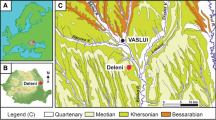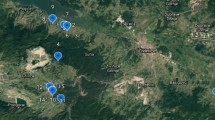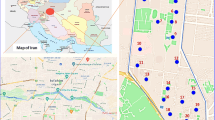Abstract
The evaluation of indoor radon exposure in dwellings is done for the first time in Lubango. The corresponding annual effective dose to which the population is exposed during the wintertime was calculated. A total of 59 single-family houses and 16 public buildings were selected. The results obtained show that in 100% of the houses, the radon concentrations are below 300 Bq m−3. The values of the indoor annual effective dose vary from (2.0 ± 0.1) to (7.0 ± 0.2) mSv y−1 below the recommended maximum reference level of 10 mSv y−1.






Similar content being viewed by others
References
Zeeb H, Shannoun F (2009) Who Handbook on Indoor radon, a public health perspective. WHO Press, Geneva
Louro A et al (2013) Human exposure to indoor radon: a survey in the region of Guarda, Portugal. Radiat Prot Dosimetry 154:237–244
Laughlin J, Bochicchio F (2007) In focus: radon and lung cancer. In: Conference: EnVIE conference on indoor air quality and health for EU policy. Helsinki (Finland).199-210
Tirmarche M, Harrison JD, Laurier D, Paquet F, Blanchardon E, Marsh JW (2010) Lung cancer risk from radon and progeny and statement on radon. Ann ICRP 40:1–64
Axelsson G, Andersson EM, Barregard L (2015) Lung cancer risk from radon exposure in dwellings in Sweden: how many cases can be prevented if radon levels are lowered? Cancer Causes Control 26:541–547. https://doi.org/10.1007/s10552-015-0531-6
Tschiersch J, Haninger T (2005) Comments on ‘adjusting lung cancer risks for temporal and spatial variations in radon concentrations in dwellings in Gansu Province, China’ by Lubin et al. Radiat Res 163:571–579
Salupeto-Dembo J, Szabó-Krausz Z, Völgyesi P, Kis Z, Szabό C (2020) External radiation exposure of the Angolan population living in adobe houses. J Radioanal Nucl Chem 323:353–364
Salupeto-Dembo J, Szabó-Krausz Z, Völgyesi P, Szabό C (2020) Radon and thoron radiation exposure of the Angolan population living in adobe houses. J Radioanal Nucl Chem 325:271–282
Kessongo J, Bahu Y, Inácio M, Peralta L, Soares S (2020) Radon concentration potential in Bibala municipality water: consequences for public consumption. Radiat Phys Chem. https://doi.org/10.1016/j.radphyschem.2020.108951
Unscear, Sources and effects of ionizing radiation United Nations Scientific Committee on the Effects of Atomic Radiation. http://large.stanford.edu/courses/2017/ph241/gutwald1/docs/unscear-2-2000.pdf. Accessed 05 April 2020
Cottinghan WN, Greenwood DA (2004) An introduction to nuclear physics. Cambridge University Press, Cambridge, United Kingdom
Huntley BJ, Russo Vladimir, Lages Fernanda, Ferrand N (2019) Angolan biodiversity: science & conservation: a modern synthesis. Springer Open, Cham, Switzerland
Wikipedia.org (2020) Cidade do Lubango. https://pt.wikipedia.org/wiki/Lubango. Acessed 4 March 2020
CESO (2020) Estudo Sobre as rochas Ornamentais em Angola. https://www.ceso.pt/pdfs/RochasOrnamentaisAngola.pdf. Accessed 8 March 2020
Pereira E, Tassinari CCG, Rodrigues JF, Van-Dúnem MV (2011) New data on the deposition age of the volcano-sedimentary chela group and its eburnean basement: implications to post-Eburnean crustal evolution of the SW of Angola. Comun Geol 98:29–40
DA Silva AF (2020) A Geologia da República de Angola desde o Paleoarcaico ao Paleozóico Inferior. Repositório do LNEG/GEOCIÊNCIAS/Geologia e Cartogr. Geológica. http://repositorio.lneg.pt/handle/10400.9/2619. Accessed 10 April 2020
McCourt S, Armstrong RA, Jelsma H, Mapeo RBM (2013) New U-Pb SHRIMP ages from the Lubango region, SW Angola: insights into the Palaeoproterozoic evolution of the Angolan Shield, southern Congo Craton, Africa. J Geol Soc London 170:353–363
Francisco Sousa do Vale MCS (1971) Carta Geológica: folha no 336 - Sá da Bandeira1:100.000. http://memoriaafrica.ua.pt/Catalog/ShowRecord.aspx?MFN=12080. Accessed 07 June 2020
ESRI (2020) A quick tour of ArcMap. https://desktop.arcgis.com/en/arcmap/10.3/main/get-started/a-quick-tour-of-arcmap.htm. Accessed 03 April 2020
ESRI (2020) ArcGIS Desktop,https://desktop.arcgis.com/en/arcmap/. Accessed 06 April 2020
Mapcruzin (2020) Download Free Angola Country, city, region, boundaries GIS Shapefile Map Layers. https://mapcruzin.com/free-angola-country-city-place-gis-shapefiles.htm. Accessed 02 April 2020
Vasilescu A (2013) CR-39 sampling of indoor radon in Southern Romania. Rom J Phys 58:311–319
Koc P, Ekinci N, Cinan E, Kavaz E (2018) Determination of radon concentration by using CR-39 plastic track detectors in dwellings of Bingöl and Mus Provinces of Turkey. Asian J Chem 30:2424–2430
Zeng Z, Cheng JG, Li J (2018) Measurements of radon concentrations using CR-39 detectors in China JinPing Underground Laboratory (2015–2016). https://arxiv.org/ftp/arxiv/papers/1806/1806.06567.pdf. Accessed 18 March 2020
Lee J (2005) Construction of an environmental radon monitoring system using Cr-39 nuclear track detectors. Nucl. Eng. Technol. 37:395–400
Shakir AA, Kadhim IH, Almayyalin AOM, Majeed FA (2016) Measurement of radon concentration in some of cosmetics by using Nuclear Track Detector (CR-39). Int J PharmTech Res 9:231–235
Sani JM, Alias N, Ahmad N, Saat A (2018) The assessment of indoor Radon-222 concentration and emanation rate at Gua Penyu, Pahang. Malays J Anal Sci 22:483–490
Hasan F (1996) Indoor radon concentration measurements at Hebron University campus: a case study Fakhri L Hasan. J Najah Edu 4:92–107
Iida T, Nurishi R, Okamoto K (1997) Passive integrating 222Rn and 220Rn CUP monitors with CR-39 detectors. Environ Int. https://doi.org/10.1016/S0160-4120(96)00166-3
Askari M, Hassanvand MS, Naddafi K, Zarei A, Yousefi M, Alimohammadi M (2019) Assessment of indoor radon concentration in residential homes and public places in south of Tehran, Iran. Environ Earth Sci 78:317
Radosys (2020) RADOSYS User Manual. https://manualzz.com/doc/7321648/1-introduction-to-the-radosys-system. Accessed 20 January 2020
ISO (2020) International Standard 11665-4. https://www.iso.org/standard/76009.html. Acsessed 30 April 2020
Kennedy M (2013) Introducing Geographic Information Systems with ArcGIS. Wiley, New Jersey, USA
Nas B, Berktay A (2010) Groundwater quality mapping in urban groundwater using GIS. Environ Monit Assess 160:215–227
Johnston K, Ver Hoef JM, Krivoruchko K, Lucas N (2001) Using ArcGIS Geostatistical Analyst. GIS by ESRI, New York, USA
Shepard D (1968) Two- dimensional interpolation function for irregularly- spaced data. Proc 23rd Nat Conf. https://doi.org/10.1145/800186.810616
Shashi Shekhar HX (2008) Encyclopedia of GIS. Spring, New York, USA
UNSCEAR (2020) 2000-Sources and effects of ionizing radiation: volume I, https://www.unscear.org/docs/publications/2000/UNSCEAR_2000_Report_Vol.I.pdf. Accessed 11 April 2020
Stojanovska Z, Januseski J, Bossew P, Zunic ZS, Tollefsen T, Ristova M (2011) Seasonal indoor radon concentration in FYR of Macedonia. Radiat Meas 46:602–610
Munyaradzi Z, Anna KN, Makondelele TV (2018) “Excess lifetime cancer risk due to natural radioactivity in soils: case of Karibib town in Namibia”, African Rev. Phys. 13:71–78
UNSCEAR (2020) Sources, Effects and Risks of Ionizing Radiation. https://www.unscear.org/docs/publications/1988/UNSCEAR_1988_Report.pdf. Accessed 10 March 2020
Brenner DJ (1994) Protection against radon-222 at home and at work. ICRP publication 65. Int J Radiat Biol 66:413
ESRI (2020) Basemaps and Imagery, Digital Map Solutions. https://www.esri.com/en-us/arcgis/products/location-services/services/basemaps. Accessed 11 April 2020
Acknowledgements
We acknowledge the support of this work by the government of the Republic of Angola through PhD grants n◦ 38/2016 and n◦ 441/2016 for J. Kessongo and Y. Bahu, respectively. We are grateful to Ashley Rose Peralta for the review of the English text.
Author information
Authors and Affiliations
Corresponding author
Ethics declarations
Conflict of interest
We state that all measurements were done with the appropriate information and permissions of local authorities, in the case of public buildings and house owners in the case of single-family houses. We further declare that we have no conflicts of interest to disclose.
Additional information
Publisher's Note
Springer Nature remains neutral with regard to jurisdictional claims in published maps and institutional affiliations.
Rights and permissions
About this article
Cite this article
Bahu, Y., Kessongo, J., Peralta, L. et al. Exposure to radon in buildings in the municipality of Lubango, Angola, during winter months. J Radioanal Nucl Chem 327, 635–642 (2021). https://doi.org/10.1007/s10967-020-07570-2
Received:
Accepted:
Published:
Issue Date:
DOI: https://doi.org/10.1007/s10967-020-07570-2




